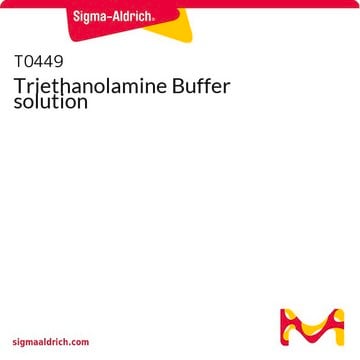Products may be shipped at a different temperature than the recommended long-term storage temperature. If the product quality is sensitive to short-term exposure to conditions other than the recommended long-term storage, it will be shipped on wet or dry-ice. If the product quality is NOT affected by short-term exposure to conditions other than the recommended long-term storage, it will be shipped at ambient temperature. As shipping routes are configured for minimum transit times, shipping at ambient temperature helps control shipping costs for our customers. For more information, please refer to the Storage and Transport Conditions document: https://www.sigmaaldrich.com/deepweb/assets/sigmaaldrich/marketing/global/documents/316/622/storage-transport-conditions-mk.pdf
サイズを選択してください
About This Item
おすすめの製品
グレード
reagent grade
品質水準
蒸気密度
5.14 (vs air)
蒸気圧
0.01 mmHg ( 20 °C)
アッセイ
98%
フォーム
viscous liquid
自己発火温度
600 °F
expl. lim.
8.5 %
屈折率
n20/D 1.485 (lit.)
有効pH範囲
7.3-8.3
pKa (25 °C)
7.8
bp
190-193 °C/5 mmHg (lit.)
mp
17.9-21 °C (lit.)
溶解性
soluble 149 g/L at 20 °C (completely)
密度
1.124 g/mL at 25 °C (lit.)
官能基
amine
hydroxyl
SMILES記法
OCCN(CCO)CCO
InChI
1S/C6H15NO3/c8-4-1-7(2-5-9)3-6-10/h8-10H,1-6H2
InChI Key
GSEJCLTVZPLZKY-UHFFFAOYSA-N
類似した製品をお探しですか? 訪問 製品比較ガイド
保管分類コード
10 - Combustible liquids
WGK
WGK 1
引火点(°F)
354.2 °F - closed cup
引火点(℃)
179 °C - closed cup
個人用保護具 (PPE)
Eyeshields, Gloves, type ABEK (EN14387) respirator filter
適用法令
試験研究用途を考慮した関連法令を主に挙げております。化学物質以外については、一部の情報のみ提供しています。 製品を安全かつ合法的に使用することは、使用者の義務です。最新情報により修正される場合があります。WEBの反映には時間を要することがあるため、適宜SDSをご参照ください。
消防法
第4類:引火性液体
第三石油類
危険等級III
水溶性液体
労働安全衛生法名称等を表示すべき危険物及び有害物
名称等を表示すべき危険物及び有害物
労働安全衛生法名称等を通知すべき危険物及び有害物
名称等を通知すべき危険物及び有害物
Jan Code
T58300-1KG-PW:
T58300-25G-PW:
T58300-25L:
T58300-25G:4548173951898
T58300-2.5L:
T58300-500ML:
T58300-BULK:
T58300-4KG:4548173951904
T58300-20KG:4548173951881
T58300-1KG:4548173951874
T58300-PZ:
T58300-VAR:
T58300-25ML:
T58300-4KG-PW:
T58300-20KG-PW:
この製品を見ている人はこちらもチェック
-
How is shipping temperature determined? And how is it related to the product storage temperature?
1 回答-
役に立ちましたか?
-
-
How can I determine the shelf life / expiration / retest date of this product?
1 回答-
If this product has an expiration or retest date, it will be shown on the Certificate of Analysis (COA, CofA). If there is no retest or expiration date listed on the product's COA, we do not have suitable stability data to determine a shelf life. For these products, the only date on the COA will be the release date; a retest, expiration, or use-by-date will not be displayed.
For all products, we recommend handling per defined conditions as printed in our product literature and website product descriptions. We recommend that products should be routinely inspected by customers to ensure they perform as expected.
For products without retest or expiration dates, our standard warranty of 1 year from the date of shipment is applicable.
For more information, please refer to the Product Dating Information document: https://www.sigmaaldrich.com/deepweb/assets/sigmaaldrich/marketing/global/documents/449/386/product-dating-information-mk.pdf役に立ちましたか?
-
-
Is this a product solid form or in liquid form ??
1 回答-
As mentioned in the 'PROPERTIES' section, this product is supplied as a viscous liquid. The melting point range is 17.9 - 21 °C. The product may solidify at lower temperatures. Warming the material to reliquify will not impact the integrity of the material.
役に立ちましたか?
-
-
Why was the product T58300 Triethanolamine received in a solid state when it is supposed to be a liquid?
1 回答-
Triethanolamine has a low melting point of 17.9 - 21°C, and it is a viscous liquid above 22 degrees Celsius. During the coldest months of the year, if the atmospheric temperature is below 21 degrees Celsius, this liquid product will arrive in a solid state. To remedy this, place the bottle in a water bath above 22 degrees Celsius to melt the product. The quality of the product will not be affected by status changes.
役に立ちましたか?
-
-
What is the boiling point of Product T58300, Triethanolamine?
1 回答-
The boiling point is not determined by Sigma-Aldrich, but is reported to be 190-193°C at a reduced pressure of 5mm Hg.
役に立ちましたか?
-
-
Product T58300, Triethanolamine, was received as a solid and it usually arrives as a liquid. Is the product still acceptable?
1 回答-
Yes, the product is still acceptable. Triethanolamine has a melting point of 17.9-21°C, which is near room temperature. The item ships under ambient conditions. As a result, it may arrive as a solid when exposed to cold temperatures (especially during the winter months). Gentle heating in a warm water bath will easily convert the material back into its expected viscous liquid appearance.
役に立ちましたか?
-
-
What is the Department of Transportation shipping information for this product?
1 回答-
Transportation information can be found in Section 14 of the product's (M)SDS.To access the shipping information for this material, use the link on the product detail page for the product.
役に立ちましたか?
-
-
How can I dilute Product T58300, Triethanolamine?
1 回答-
According to the chemicals encyclopedia published by the Royal Society of Chemistry (which we also offer as product Z705322), triethanolamine is expected to be miscible with water, methanol or acetone.
役に立ちましたか?
-
-
What kind of gloves would be recommended when working with Product T58300, Triethanolamine?
1 回答-
When working with the material, we would recommend neoprene, nitrile or butyl gloves. For example, the Best® butyl, ChemMaster™ or N-DEX® gloves.
役に立ちましたか?
-
アクティブなフィルタ
ライフサイエンス、有機合成、材料科学、クロマトグラフィー、分析など、あらゆる分野の研究に経験のあるメンバーがおります。.
製品に関するお問い合わせはこちら(テクニカルサービス)





